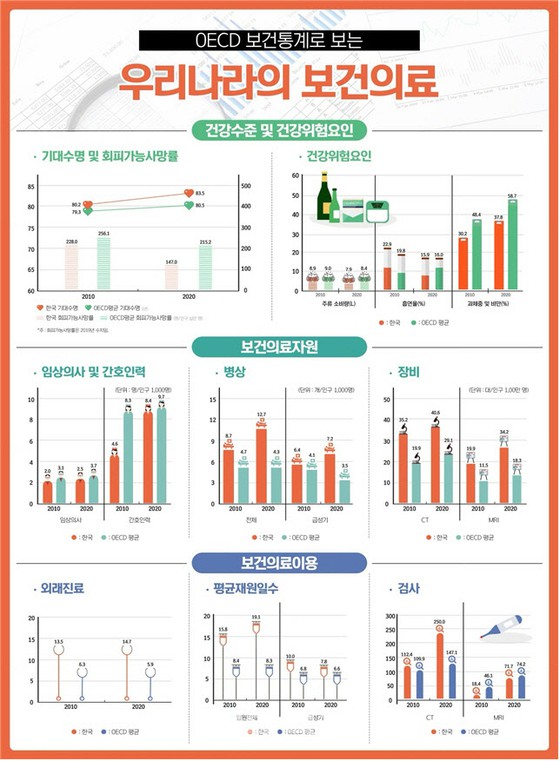 |
On May 26th, the Ministry of Health and Welfare released the levels and current status of each country by major indicator in the OECD Health Statistics 2022, which was released by the OECD earlier July.
First, the suicide rate was 25.4, the highest among OECD countries. Although the number has decreased by about 10 over the past decade from 35.3 in 2009, the figure is far more than double the OECD average (11.1).
On the other hand, looking at the item of health level, Korea's expected life expectancy was 83.5 years, the second longest among OECD member countries, following Japan's 84.7 years. This is three years longer than the OECD average of 80.5 years.
The 'avoidable death rate', meaning the death rate that can be prevented through disease prevention activities and the provision of adequate medical services, was 147.0 per 100,000 population, lower than the OECD average of 215.2. The avoidable mortality rate was the eighth lowest among OECD countries, after Switzerland, Israel, Iceland, Japan, Luxembourg, Spain and Italy.
The infant mortality rate was 2.5 per 1000 live births, lower than the OECD average of 4.1.
Looking at health risk factors, the smoking prevalence among the population aged 15 and over in South Korea was 15.9%, similar to the OECD average of 16.0%. Per capita annual alcohol consumption was 7.9 liters, less than the OECD average (8.4 liters).
The percentage of overweight and obese people aged 15 and over was 37.8%, the second lowest after Japan (27.2%). The OECD average is 58.7%. However, while smoking rates and alcohol consumption have trended downward over the decade, rates of overweight and obesity have trended upward.
The number of clinicians, including traditional Chinese medicine practitioners, per 1,000 population was 2.5, the second lowest among OECD countries after Mexico. The OECD average is 3.7, while Austria ranks first with 5.4. There are 7.2 medical school graduates per 100,000 population. The third lowest after Japan and Israel with 6.9 each. The OECD average is 13.2.
Annual income for physicians was $195,463 for practicing physicians and $303,007 for practitioners, both of which were the highest among OECD member countries. The wage gap between practicing physicians and practicing physicians was the second largest after Belgium.
In terms of the number of times medical services were used, the number of outpatient visits per capita per year was 14.7, the highest among OECD member countries, and the average length of hospital stay was 19.1 days, second highest among OECD member countries.
Ordinary medical expenses, which represent the total annual expenditure of the entire population on services in the health sector, were 8.4% of Korea's GDP in 2020, lower than the OECD average (9.7%).
Routine medical expenses per capita amounted to $3,582, increasing by an average of 6.9% annually over the past decade, showing a higher growth rate than the OECD average (3.3%). The percentage of medical expenses actually borne by households is 34.0% in 2010, 33.7% in 2015, and 27.8% in 2020, showing a gradual decline. Pharmaceutical sales per capita in South Korea were $760, higher than the OECD average of $547.
In the long-term care sector, 7.4% of people aged 65 and over were in long-term care at home and 2.6% in institutions, respectively, lower than the OECD average of 10.4% and 3.6%. The number of long-term care workers is 4.5 per 100 people aged 65 and over, below the OECD average of 6. Norway had 12.2 and Sweden had 11.6. The combined number of beds in nursing homes and long-term care facilities per 1,000 people aged 65 and over is 58.9, higher than the OECD average of 45.0.
“We will continue to work with the OECD to expand South Korea's health and medical statistics so that the public can actively utilize its diverse medical resources,” said Yang Kyung-jin, a policy and statistics official at the Ministry of Health and Welfare.
2022/07/31 09:25 KST


